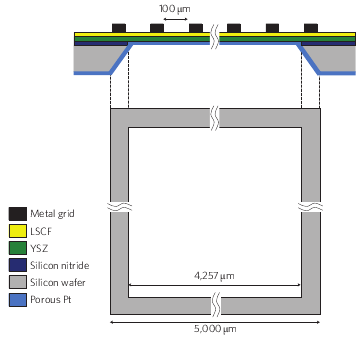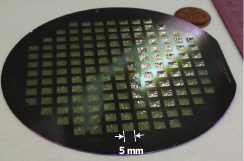| For solid-oxide fuel cell applications, high operating temperatures in excess of 700°C are necessary in order to attain sufficient oxygen-ion conductivity and reduce series resistance in the membrane in order to achieve reasonable power density. Further reducing the membrane thickness would possibly enable the operating temperature to be reduced, thereby relaxing the requirements for thermal insulation and management. Tsuchiya, et. al., describe a scalable method to integrate an ultra-thin SOFC membrane structure onto a silicon wafer support. |
Reviewed by Jeff Morse, PhD, National Nanomanufacturing Network
- Tsuchiya M, Lai BK, and Ramanathan S. 2011. Scalable Nanostructured Membranes for Solid-oxide Fuel Cells. Nature Nanotechnology Online publication 3 April 2011. doi:10.1038/NNANO.2011.43
Oxygen-ion conducting membranes find applications for a range of energy and environmental technologies including solid-oxide fuel cells (SOFCs), and electrolyzers for NOx reduction, oxygen separation, and exhaust gas sensors. Typical solid-oxide membrane synthesis routes utilize ceramic powder processing or vacuum coating techniques resulting in membrane thicknesses ranging from micron to millimeter scale. For SOFC applications, high operating temperatures in excess of 700°C are necessary in order to attain sufficient oxygen-ion conductivity and reduce series resistance in the membrane in order to achieve reasonable power density.


Testing of the integrated SOFC demonstrated 150 mW/cm2 at 510°C for a 5 mm x 5 mm membrane area. The free-standing SOFC membrane exhibited compressive stress at room temperature which relaxed after the first thermal cycle, and remained in tensile stress during subsequent thermal cycles. The ultra-thin membrane further exhibited no failure or cracking during multiple thermal cycles. Thus a scalable approach has been demonstrated for integration of thin-film membranes over many tens of square millimeters. The approach resolves critical performance issues for subsequent thermal cycling and stability at moderate to high temperature operation.
Images reproduced from Tsuchiya M,et.al., Scalable Nanostructured Membranes for Solid-oxide Fuel Cells. Nature Nanotechnology Online publication 3 April 2011. doi:10.1038/NNANO.2011.43. Permission pending.
This work is licensed under a Creative Commons Attribution-NonCommercial 3.0 Unported.
